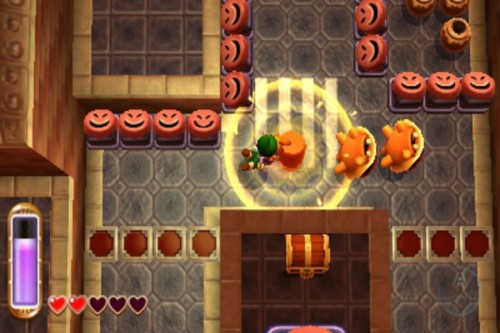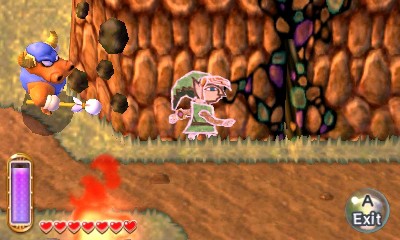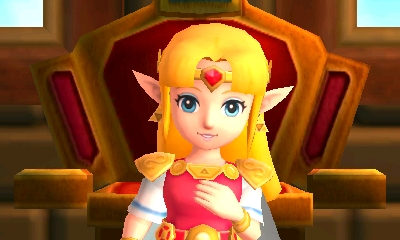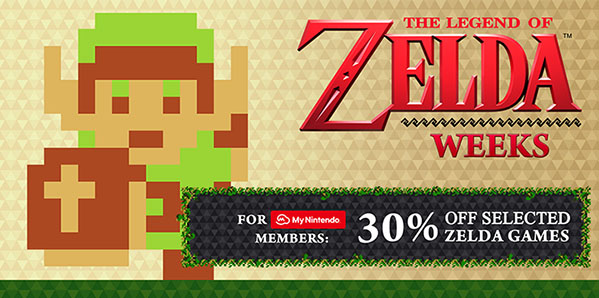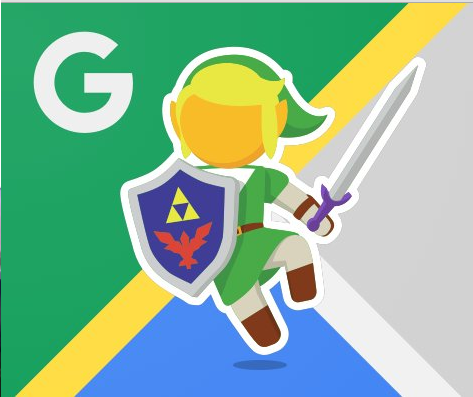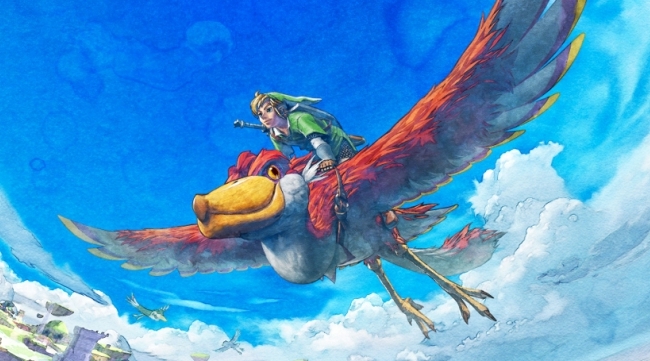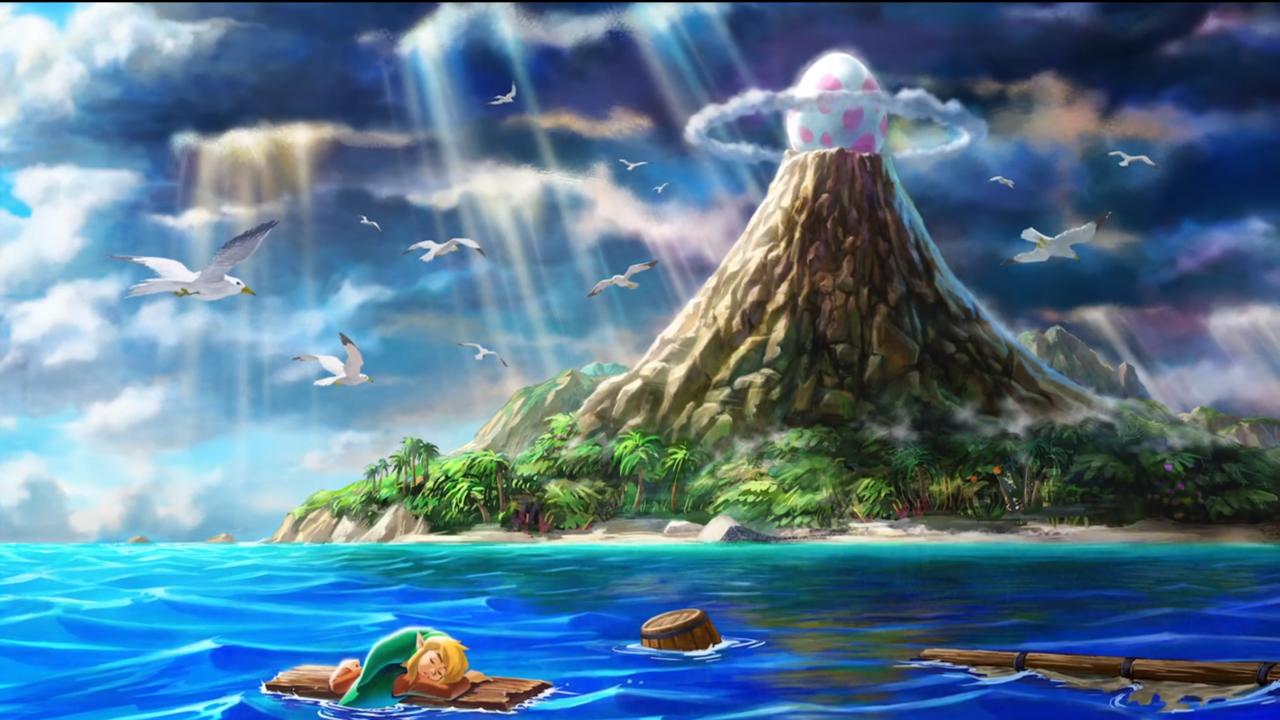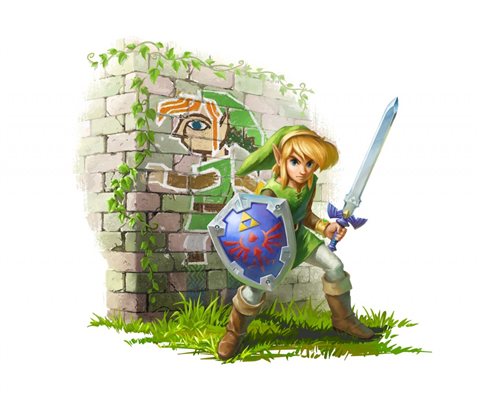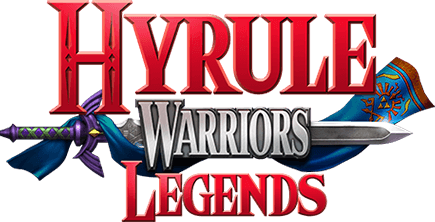
I’ve never played A Link to The Past, the 1991/92 game of which A Link Between Worlds is spiritual successor to. Beyond the more obvious new features and narrative distinctions, I can’t tell you whether the latter lives up to the former, whether it’s game play additions are strictly improvements, or whether it’s more remake or revision. What I can tell you, however, is that A Link Between Worlds is one of the most satisfying Zelda games I’ve ever played, and is easily one of the best games on 3DS.
In Between Worlds, Link’s task is to reunite the Seven Sages who’ve been cast as portraits and scattered across the land, courtesy of the evil sorcerer, Yuga. Doing so requires world-hopping between LttP’s Hyrule and its darkened counterpart, Lorule; a decaying and twisted mirror-image teeming with stronger enemies.The way these two worlds play off each other is expertly done. Each hosts a myriad of secrets, and often times progressing further in one world means picking your way through the other. You’ll also utilise more traditional inputs this time around, as opposed to the stylus-control of recent handheld titles.
Its not wholly different, then, from LttP, but if you’re concerned that Between Worlds’ narrative retreads and near-identical Hyrule is uninspired, then rest assured – it isn’t. Nintendo has made a number of clever design choices in Between Worlds which reinvigorates the aging Zelda formula, whilst still keeping its core intact.
The most notable changes relate to dungeon order and Link’s arsenal. Within two short hours you’ll have near complete access to Link’s weapons, giving you the ability to tackle the top-down over-world as you see fit. This allows the experience to unfold naturally, promoting exploration where many past Zelda games have limited it. Nintendo has also smartly dialled back the hand holding and in-game cues, too. You’ll make most of Between Worlds’ discoveries on your own, and if stuck in one area, you’re afforded the versatility to venture elsewhere in the meantime. In essence, the reigns have been loosened and it’s never felt better.
The trade-off for having a full arsenal from the get-go is that each weapon is costly and needs to be hired. Falling in battle relieves you of most items, and you’ll then have to re-hire them, or eventually purchase them outright at even greater expense. It’s a hefty consequence, but it allows for some truly thrilling encounters during times you’d usually be less engaged. There’s also plenty of mini-games and easy ways to farm rupees, which helps balance these features nicely, as well as a useful quick-travel system that benefits you the more you explore.
A significant game play addition to Link’s move-set is the merge ability, which enables the player to move horizontally along walls as a 2D painting. This results in some deviously clever puzzles and even boss fights; you’ll hide from enemies, merge across chasms, hitch rides on moving platforms, and slip through cracks to open up new areas. In short, Zelda’s puzzles tend to rate amongst the best in the business, and Between Worlds is no exception.
An energy meter governs the length of time you can merge and use items, but it recharges quickly enough to avoid becoming an annoyance. Moreover, entering a dungeon automatically displays its map on the 3DS’ bottom screen (i.e. you won’t have to retrieve this item), which serves to ease navigation against some of the more taxing puzzles. The combined result of these tweaks is that the game play remains challenging, but never to the detriment of pacing.
There’s also new additions which make specific use of the 3DS’ native features. Carrying the handheld with you in Sleep Mode will amass coins which unlock in-game hints, but it’s an voluntary feature if you wish to play unassisted. Elsewhere, players can leverage StreetPass to project a ‘Shadow Link” in another’s game, or duel one which has appeared in their own playthrough. These award the winner with a bounty of rupees based on the difficulty of the duel, but losing one won’t penalise you. As such, both additions are welcome ones; they’re never intrusive and entirely optional.
In terms of presentation, Between World hits all the right notes you’d come to expect. The soundtrack is fantastic, and the little touches, such as how the music distorts when Link is in 2D, will have you smiling before long. The use of 3D is particularly well-implemented too, combining nicely with the game’s top-down perspective. Whether it’s arrows bouncing up towards the screen upon deflection, or the way Link moves seamlessly between the higher and lower levels of each dungeon, the 3D adds to the experience in appealing ways without feeling overly gimmicky.
One criticism I would level is that, due to Between Worlds‘ open-ended nature, it’s impossible to know which tasks to prioritise. For example, one dungeon I traversed late-game gifted damage-halving armour, which would have been infinitely more useful had I known of it’s existence earlier. Even so, you could argue these scenarios are ‘half the fun.’ You might not progress through Between Worlds in the ‘ideal’ way, but your adventure will be uniquely your own, and can therefore be just as gratifying.
Overall, Between Worlds is the strongest Zelda title I’ve witnessed in some time. No doubt some will inevitably miss the drip-feed of progressively stronger items, tighter narrative structure, and general familiarities the series has nurtured over the years, but breaking away from formula has provided some much-needed fresh air. The noted changes may have overwhelmed at first, but I’ve since asked myself: ‘Could I fall back into Zelda’s more traditional formula, post-Between Worlds?’
I honestly don’t know the answer, and that, alone, is the highest compliment I could give.
Tweaks to traditional formula sparks new life into series | Less restrictive design | Exploration and combat all perfectly paced, balanced, etc. | Rewarding puzzle-solving | Stunning presentation across visuals and soundtrack
Prioritising objectives is not feasible on first playthrough

